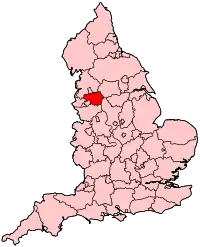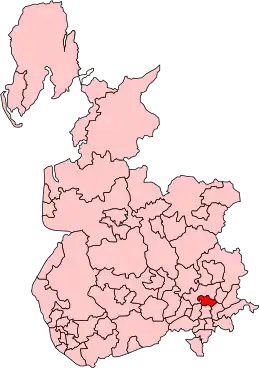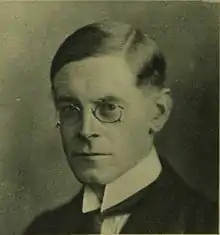Manchester Blackley (UK Parliament constituency)
Manchester, Blackley /ˈbleɪkli/ was a borough constituency represented in the House of Commons of the Parliament of the United Kingdom. It elected one Member of Parliament (MP) by the first past the post system of election. In boundary changes for the 2010 general election it was replaced by Blackley and Broughton.
| Manchester, Blackley | |
|---|---|
| Former Borough constituency for the House of Commons | |
 Boundary of Manchester, Blackley in Greater Manchester for the 2005 general election | |
 Location of Greater Manchester within England | |
| County | Greater Manchester |
| 1918–2010 | |
| Number of members | One |
| Replaced by | Blackley and Broughton |
| Created from | Prestwich, Manchester North West and Manchester North |
Boundaries

1918–1983: The County Borough of Manchester wards of Blackley, Crumpsall, and Moston.
1983–2010: The City of Manchester wards of Blackley, Charlestown, Crumpsall, Harpurhey, Lightbowne, and Moston.
This constituency was one of Labour's safest seats, though prior to 1964 it was regarded as a reasonably safe Conservative seat, with the party only gaining the seat once, in their 1945 landslide victory. Located in the North of the city, it included the overspill area of Blackley, the deprived inner-city area of Harpurhey, and the districts of Moston, Crumpsall and Charlestown.
Boundary review
From 2010 this seat was abolished, and its constituents form one part of the Blackley and Broughton seat with two electoral wards from Salford.
Members of Parliament
| Election | Member[1] | Party | |
|---|---|---|---|
| 1918 | Harold Briggs | Conservative | |
| 1923 | Philip Oliver | Liberal | |
| 1924 | Harold Briggs | Conservative | |
| 1929 | Philip Oliver | Liberal | |
| 1931 | John Lees-Jones | Conservative | |
| 1945 | Jack Diamond | Labour | |
| 1951 | Eric Johnson | Conservative | |
| 1964 | Paul Rose | Labour | |
| 1979 | Ken Eastham | Labour | |
| 1997 | Graham Stringer | Labour | |
| 2010 | constituency abolished: see Blackley and Broughton | ||
Elections
Elections in the 2000s
| Party | Candidate | Votes | % | ±% | |
|---|---|---|---|---|---|
| Labour | Graham Stringer | 17,187 | 62.3 | −6.6 | |
| Liberal Democrats | Iain Donaldson | 5,160 | 18.7 | +7.3 | |
| Conservative | Amar Ahmed | 3,690 | 13.4 | −1.0 | |
| UKIP | Roger Bullock | 1,554 | 5.6 | New | |
| Majority | 12,027 | 43.6 | -10.8 | ||
| Turnout | 27,591 | 45.8 | +0.9 | ||
| Labour hold | Swing | −7.0 | |||
| Party | Candidate | Votes | % | ±% | |
|---|---|---|---|---|---|
| Labour | Graham Stringer | 18,285 | 68.9 | −1.1 | |
| Conservative | Lance Stanbury | 3,821 | 14.4 | -0.9 | |
| Liberal Democrats | Gary Riding | 3,015 | 11.4 | +0.4 | |
| Socialist Labour | Kenneth Barr | 485 | 1.8 | New | |
| Socialist Alliance | Karren Reissmann | 461 | 1.7 | New | |
| Anti-Corruption Forum | Aziz Bhatti | 456 | 1.7 | New | |
| Majority | 14,464 | 54.4 | -0.4 | ||
| Turnout | 26,523 | 44.9 | -12.3 | ||
| Labour hold | Swing | -7.0 | |||
Elections in the 1990s
| Party | Candidate | Votes | % | ±% | |
|---|---|---|---|---|---|
| Labour | Graham Stringer | 25,042 | 70.0 | +9.8 | |
| Conservative | Stephen Barclay | 5,454 | 15.3 | −12.5 | |
| Liberal Democrats | Simon D. Wheale | 3,937 | 11.0 | −0.3 | |
| Referendum | Paul Stayner | 1,323 | 3.7 | New | |
| Majority | 19,588 | 54.8 | +22.4 | ||
| Turnout | 35,756 | 57.2 | -12.1 | ||
| Labour hold | Swing | +11.2 | |||
| Party | Candidate | Votes | % | ±% | |
|---|---|---|---|---|---|
| Labour | Ken Eastham | 23,031 | 60.2 | +7.8 | |
| Conservative | William S. Hobhouse | 10,642 | 27.8 | −1.0 | |
| Liberal Democrats | Simon D. Wheale | 4,324 | 11.3 | −7.5 | |
| Natural Law | Michael P. Kennedy | 288 | 0.8 | New | |
| Majority | 12,389 | 32.4 | +8.8 | ||
| Turnout | 38,285 | 69.3 | −3.6 | ||
| Labour hold | Swing | +4.4 | |||
Elections in the 1980s
| Party | Candidate | Votes | % | ±% | |
|---|---|---|---|---|---|
| Labour | Ken Eastham | 22,476 | 52.4 | +4.3 | |
| Conservative | Krishan Nath | 12,354 | 28.8 | −3.8 | |
| SDP | Harvey Showman | 8,041 | 18.8 | New | |
| Majority | 10,122 | 23.6 | +8.2 | ||
| Turnout | 42,871 | 72.9 | +3.2 | ||
| Labour hold | Swing | +4.1 | |||
| Party | Candidate | Votes | % | ±% | |
|---|---|---|---|---|---|
| Labour | Ken Eastham | 20,132 | 48.1 | −2.8 | |
| Conservative | Peter C.J. Ridgway | 13,676 | 32.6 | +0.1 | |
| Liberal | John Cookson | 8,081 | 19.3 | +5.1 | |
| Majority | 6,456 | 15.4 | −3.0 | ||
| Turnout | 41,889 | 69.7 | −3.6 | ||
| Labour hold | Swing | −1.5 | |||
Elections in the 1970s
| Party | Candidate | Votes | % | ±% | |
|---|---|---|---|---|---|
| Labour | Ken Eastham | 20,346 | 50.4 | −0.5 | |
| Conservative | Arthur Green | 15,842 | 39.2 | +3.7 | |
| Liberal | James Ashley | 3,868 | 9.6 | −4.6 | |
| National Front | Nigel Wallace | 326 | 0.8 | -1.6 | |
| Majority | 4,504 | 11.2 | -7.2 | ||
| Turnout | 40,382 | 76.4 | +5.8 | ||
| Labour hold | Swing | −2.1 | |||
| Party | Candidate | Votes | % | ±% | |
|---|---|---|---|---|---|
| Labour | Paul Rose | 19,720 | 50.9 | +4.1 | |
| Conservative | A. Lea | 12,601 | 35.5 | −1.0 | |
| Liberal | D. Jackson | 5,517 | 14.2 | −5.5 | |
| National Front | Herbert Andrew | 914 | 2.4 | New | |
| Majority | 7,119 | 18.4 | +5.1 | ||
| Turnout | 38,752 | 70.6 | -5.5 | ||
| Labour hold | Swing | +3.0 | |||
| Party | Candidate | Votes | % | ±% | |
|---|---|---|---|---|---|
| Labour | Paul Rose | 19,369 | 46.8 | −6.4 | |
| Conservative | Hugh Roderick Lynn Samuel | 13,863 | 33.5 | −13.3 | |
| Liberal | Harry Roche | 8,155 | 19.7 | New | |
| Majority | 5,506 | 13.3 | 6.9 | ||
| Turnout | 41,387 | 76.1 | +6.6 | ||
| Labour hold | Swing | −3.5 | |||
| Party | Candidate | Votes | % | ±% | |
|---|---|---|---|---|---|
| Labour | Paul Rose | 21,437 | 53.2 | -1.2 | |
| Conservative | Albert Maguire | 18,838 | 46.8 | +9.7 | |
| Majority | 2,599 | 6.4 | -8.9 | ||
| Turnout | 40,275 | 69.5 | -6.0 | ||
| Labour hold | Swing | -5.5 | |||
Elections in the 1960s
| Party | Candidate | Votes | % | ±% | |
|---|---|---|---|---|---|
| Labour | Paul Rose | 21,571 | 54.4 | +10.8 | |
| Conservative | David C Stanley | 15,271 | 37.1 | -3.8 | |
| Liberal | Lawrence Gordon Bayley | 4,297 | 10.5 | -5.1 | |
| Majority | 6,300 | 15.3 | +12.6 | ||
| Turnout | 41,139 | 75.5 | -4.0 | ||
| Labour hold | Swing | +7.3 | |||
| Party | Candidate | Votes | % | ±% | |
|---|---|---|---|---|---|
| Labour | Paul Rose | 19,570 | 43.6 | +5.9 | |
| Conservative | Eric Johnson | 18,348 | 40.9 | -6.1 | |
| Liberal | Robert Michael Hammond | 7,002 | 15.6 | +0.3 | |
| Majority | 1,222 | 2.7 | N/A | ||
| Turnout | 44,920 | 79.5 | -1.7 | ||
| Labour gain from Conservative | Swing | +6.0 | |||
Elections in the 1950s
| Party | Candidate | Votes | % | ±% | |
|---|---|---|---|---|---|
| Conservative | Eric Johnson | 22,163 | 47.0 | -9.0 | |
| Labour | Reginald Chrimes | 17,790 | 37.7 | -6.3 | |
| Liberal | Robert Michael Hammond | 7,223 | 15.3 | New | |
| Majority | 4,373 | 9.3 | -2.7 | ||
| Turnout | 47,176 | 81.2 | +3.9 | ||
| Conservative hold | Swing | -1.4 | |||
| Party | Candidate | Votes | % | ±% | |
|---|---|---|---|---|---|
| Conservative | Eric Johnson | 23,395 | 56.0 | +7.0 | |
| Labour | John Diamond | 19,959 | 44.0 | -0.6 | |
| Majority | 5,436 | 12.0 | +7.6 | ||
| Turnout | 43,354 | 77.3 | -8.3 | ||
| Conservative hold | Swing | +3.2 | |||
| Party | Candidate | Votes | % | ±% | |
|---|---|---|---|---|---|
| Conservative | Eric Johnson | 25,076 | 49.0 | +6.8 | |
| Labour | John Diamond | 22,804 | 44.6 | +2.3 | |
| Liberal | Frank Smith | 3,287 | 6.4 | -8.0 | |
| Majority | 2,272 | 4.4 | N/A | ||
| Turnout | 51,167 | 85.6 | +0.9 | ||
| Conservative gain from Labour | Swing | +2.3 | |||
| Party | Candidate | Votes | % | ±% | |
|---|---|---|---|---|---|
| Labour | John Diamond | 21,392 | 42.3 | -2.4 | |
| Conservative | R Jamieson | 21,350 | 42.1 | +8.5 | |
| Liberal | Henry Donald Moore | 7,317 | 14.5 | -7.2 | |
| Communist | Ben Ainley[9] | 562 | 1.1 | New | |
| Majority | 42 | 0.2 | -10.8 | ||
| Turnout | 50,621 | 85.7 | +10.9 | ||
| Labour hold | Swing | -5.5 | |||
Elections in the 1940s
| Party | Candidate | Votes | % | ±% | |
|---|---|---|---|---|---|
| Labour | John Diamond | 19,561 | 44.7 | +17.6 | |
| Conservative | John Lees-Jones | 14,747 | 33.7 | -10.6 | |
| Liberal | Philip Oliver | 9,480 | 21.7 | -6.9 | |
| Majority | 4,814 | 11.0 | N/A | ||
| Turnout | 43,788 | 74.8 | -3.3 | ||
| Labour gain from Conservative | Swing | +14.1 | |||
Elections in the 1930s
| Party | Candidate | Votes | % | ±% | |
|---|---|---|---|---|---|
| Conservative | John Lees-Jones | 15,355 | 44.3 | -2.1 | |
| Liberal | Philip Oliver | 9,893 | 28.6 | -5.0 | |
| Labour | WE Davies | 9,370 | 27.1 | +7.1 | |
| Majority | 5,462 | 15.7 | +2.9 | ||
| Turnout | 34,618 | 78.1 | -6.0 | ||
| Conservative hold | Swing | +1.4 | |||
| Party | Candidate | Votes | % | ±% | |
|---|---|---|---|---|---|
| Conservative | John Lees-Jones | 15,717 | 46.4 | +12.9 | |
| Liberal | Philip Oliver | 11,382 | 33.6 | -2.8 | |
| Labour | Wilfrid Burke | 6,752 | 20.0 | -10.1 | |
| Majority | 4,335 | 12.8 | N/A | ||
| Turnout | 33,851 | 84.1 | +1.5 | ||
| Conservative gain from Liberal | Swing | +7.8 | |||
Elections in the 1920s

| Party | Candidate | Votes | % | ±% | |
|---|---|---|---|---|---|
| Liberal | Philip Oliver | 11,006 | 36.4 | +7.1 | |
| Unionist | Harold Briggs | 10,118 | 33.5 | -9.7 | |
| Labour | Wilfrid Burke | 9,091 | 30.1 | +2.6 | |
| Majority | 888 | 2.9 | N/A | ||
| Turnout | 30,275 | 82.6 | -2.9 | ||
| Liberal gain from Unionist | Swing | +7.7 | |||
| Party | Candidate | Votes | % | ±% | |
|---|---|---|---|---|---|
| Unionist | Harold Briggs | 9,737 | 43.2 | +10.5 | |
| Liberal | Philip Oliver | 6,609 | 29.3 | -33.3 | |
| Labour | Wilfrid Burke | 6,195 | 27.5 | New | |
| Majority | 3,128 | 13.9 | N/A | ||
| Turnout | 22,541 | 85.5 | +10.1 | ||
| Unionist gain from Liberal | Swing | +21.9 | |||
| Party | Candidate | Votes | % | ±% | |
|---|---|---|---|---|---|
| Liberal | Philip Oliver | 12,235 | 62.6 | +32.7 | |
| Unionist | Harold Briggs | 7,313 | 37.4 | -5.9 | |
| Majority | 4,922 | 25.2 | N/A | ||
| Turnout | 19,548 | 75.4 | |||
| Liberal gain from Unionist | Swing | +19.3 | |||
| Party | Candidate | Votes | % | ±% | |
|---|---|---|---|---|---|
| Unionist | Harold Briggs | 9,023 | 43.3 | -11.3 | |
| Liberal | Philip Oliver | 6,219 | 29.9 | +9.5 | |
| Labour | Arnold Townend | 5,580 | 26.8 | +1.8 | |
| Majority | 2,804 | 13.4 | -16.2 | ||
| Turnout | 20,822 | ||||
| Unionist hold | Swing | -10.4 | |||
Elections in the 1910s
| Party | Candidate | Votes | % | ±% | |
|---|---|---|---|---|---|
| Unionist | Harold Briggs | 7,997 | 54.6 | ||
| Labour | Arnold Townend | 3,659 | 25.0 | ||
| Liberal | Philip Oliver | 2,986 | 20.4 | ||
| Majority | 4,338 | 29.6 | |||
| Turnout | 14,642 | 58.9 | |||
| Unionist win (new seat) | |||||
No candidate who was endorsed by the Coalition Government.
Notes and references
Craig, F. W. S. (1983). British parliamentary election results 1918-1949 (3 ed.). Chichester: Parliamentary Research Services. ISBN 0-900178-06-X.
- Leigh Rayment's Historical List of MPs – Constituencies beginning with "B" (part 3)
- "Election Data 2005". Electoral Calculus. Archived from the original on 15 October 2011. Retrieved 18 October 2015.
- "Election Data 2001". Electoral Calculus. Archived from the original on 15 October 2011. Retrieved 18 October 2015.
- "Election Data 1997". Electoral Calculus. Archived from the original on 15 October 2011. Retrieved 18 October 2015.
- "Election Data 1992". Electoral Calculus. Archived from the original on 15 October 2011. Retrieved 18 October 2015.
- "Politics Resources". Election 1992. Politics Resources. 9 April 1992. Archived from the original on 24 July 2011. Retrieved 6 Dec 2010.
- "Election Data 1987". Electoral Calculus. Archived from the original on 15 October 2011. Retrieved 18 October 2015.
- "Election Data 1983". Electoral Calculus. Archived from the original on 15 October 2011. Retrieved 18 October 2015.
- Stevenson, Graham. "Ainley Ben". Retrieved 29 April 2017.
- British parliamentary election results, 1918-1949 by Fred W. S. Craig
- British parliamentary election results, 1918-1949 by Fred W. S. Craig
- British parliamentary election results, 1918-1949 by Fred W. S. Craig
- British parliamentary election results, 1918-1949 by Fred W. S. Craig
- British parliamentary election results, 1918-1949 by Fred W. S. Craig
- British parliamentary election results, 1918-1949 by Fred W. S. Craig
- British parliamentary election results, 1918-1949 by Fred W. S. Craig
- British parliamentary election results, 1918-1949 by Fred W. S. Craig